Google Pixel XL Review
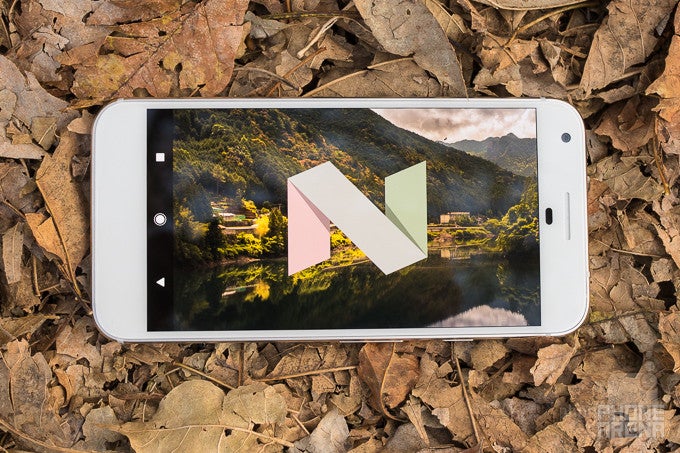
Update: You can now read our Google Pixel 2 and Pixel 2 XL review!
Introduction
Ask a dozen people what kind of company Google is, and you'll get a dozen different answers. It's a search company; an advertising provider; a cloud-services firm; a social network; a publisher; an entertainment hub – we could go on. And while “hardware company” is pretty far from first on that list, it's a role we see Google return to time and time again, and with some markedly renewed vigor in recent years.
While we've had Google smartphones since the early days of Android, thanks to the Nexus program, lately it's felt like Google's attitude towards phone hardware has been shifting. There were a couple years of affordable phones, a return to flagship-level prices, and most recently an emphasis on phablet-sized models. But this year Google's smartphone operations are undergoing arguably their most meaningful change since the launch of the Nexus One, as the Nexus brand fades into the background, replaced by Google's new duo of Pixel phones.
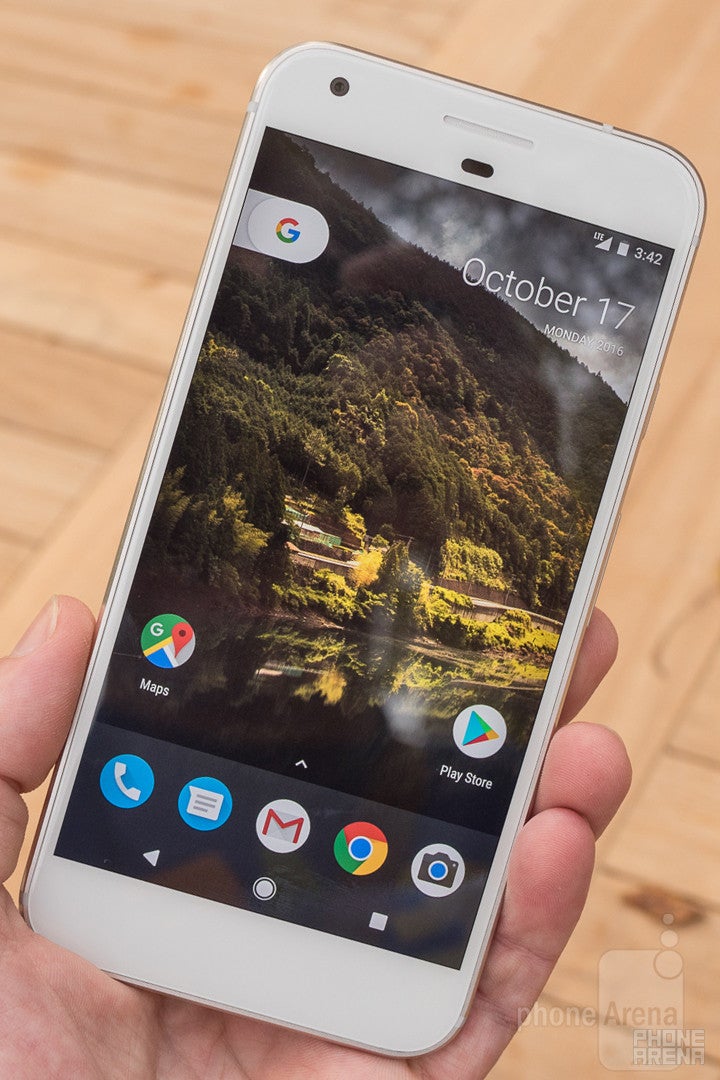
What does all this mean for the actual Pixel phones? Has Google brought us some devices that have what it takes to steer shoppers away from high-profile handsets like Samsung's Galaxy lineup? Or will Pixel end up feeling more like a niche item for the tech-savvy or those who like to live on the bleeding edge – a characterization frequently visited upon Nexus phones? Let's find out, as we take a look at the larger of the two new Pixel phones, the 5.5-inch Pixel XL.
In the box:
- Google Pixel XL
- USB Type-C to Type-C cable
- USB Type-C to Standard-A cable
- USB Type-C to Standard-A (Quick Switch) adapter
- Power adapter
- SIM tool
- Intro cards (hardware, thank you, Google Assistant, Play Music 3-month trial)
- Warranty booklet
Design
An ambitious design brings us a Google phone that may well have other manufacturers feeling jealous
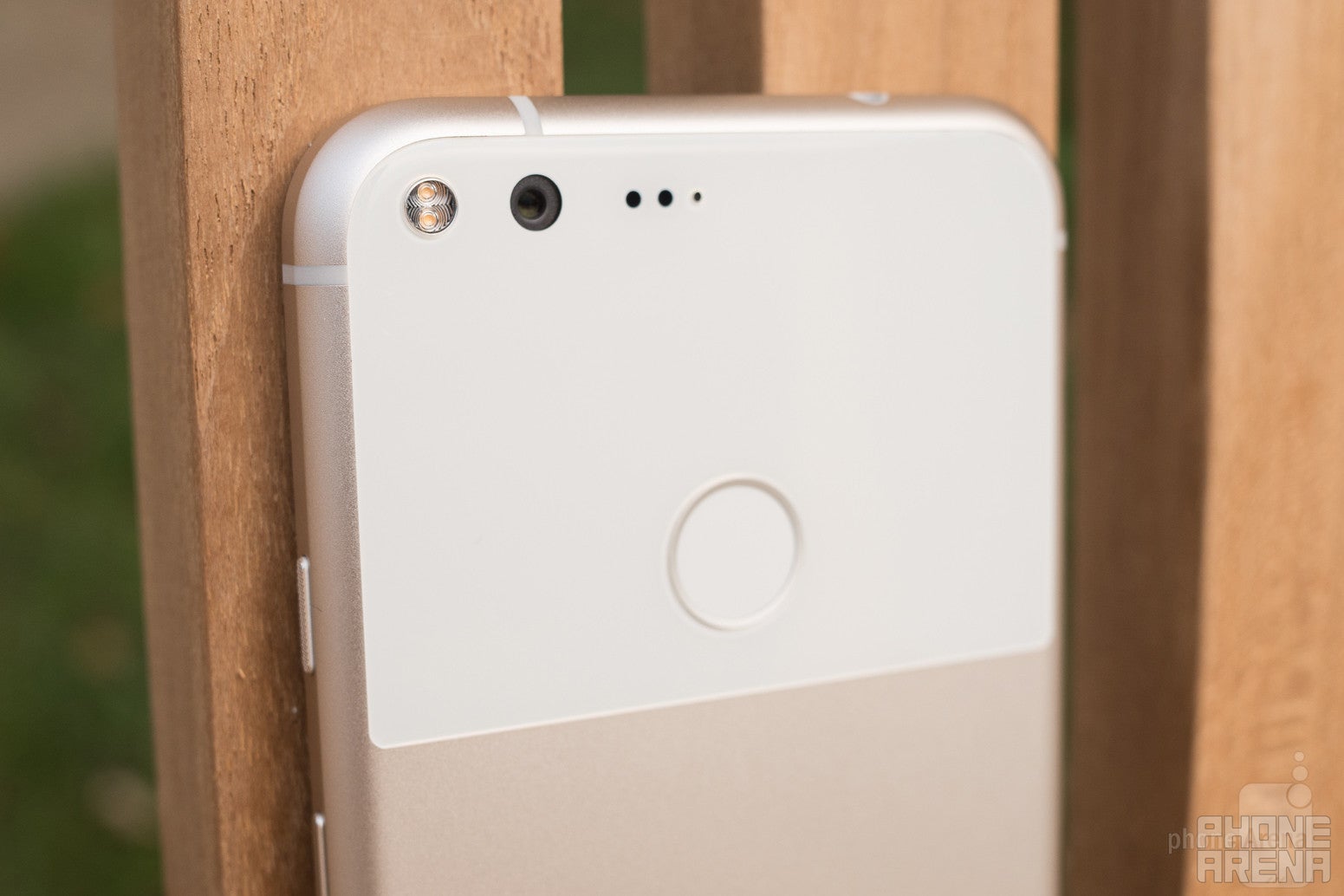
Crafting a smartphone these days that offers a unique look is no small feat. As some brands churn out featureless slate after featureless slate, or others find themselves repeating variations on the same standard design over and over again, a breath of fresh air can be hard to come by. But with Google's new Pixel phones, the company may have done just that.
Maybe the first thing you'll notice about the Pixel XL – and the smaller Pixel, as well, which shares the same basic design – is this glass panel consuming the upper third of the phone's otherwise metal back. We've seen smaller adornments like this before (think: the camera “stripe” on last year's Nexus 6P), but the Pixel XL pushes it to a whole new level. At first, it's a look that may inspire some push-back; after all, it's easy to think of metal as a particularly robust and premium smartphone material, while glass just seems all sorts of damage-prone.
While time will tell just how well the Pixel XL holds up to a little use (and abuse), it didn't take long for us to come around to the phone's partially glass-covered back. One real benefit is the tactile effect the use of multiple materials affords, making it particularly easy to reach into your pocket and instantly know which direction the phone's facing. And while we can't deny that the glass is more fingerprint-prone than the metal making up the rest of the back, its aesthetics have really started to grow on us.
Moving around the hardware, we've got a USB Type-C port and the phone's (mono) speaker on its bottom edge, the SIM tray on the right (with no hybrid microSD functionality – this is Google, after all), an analog headphone jack up top, and the power button and volume rocker on the right. The edge sports a hybrid design of its own, with a smooth curve transitioning to the phone's back, an angled bevel marking the move to the handset's face, and a solid, flat stripe in the center. The effect there makes for a phone that feels seriously nice to hold, while also offering a comfortably solid grip.
With all this metal, the Pixel XL has some appreciable heft to it, coming in at 168 grams. That's right about the same as the Note 7, though a bit lighter than the iPhone 7 Plus.
Display
Bold and crisp, sure, but other specs fall short of the mark
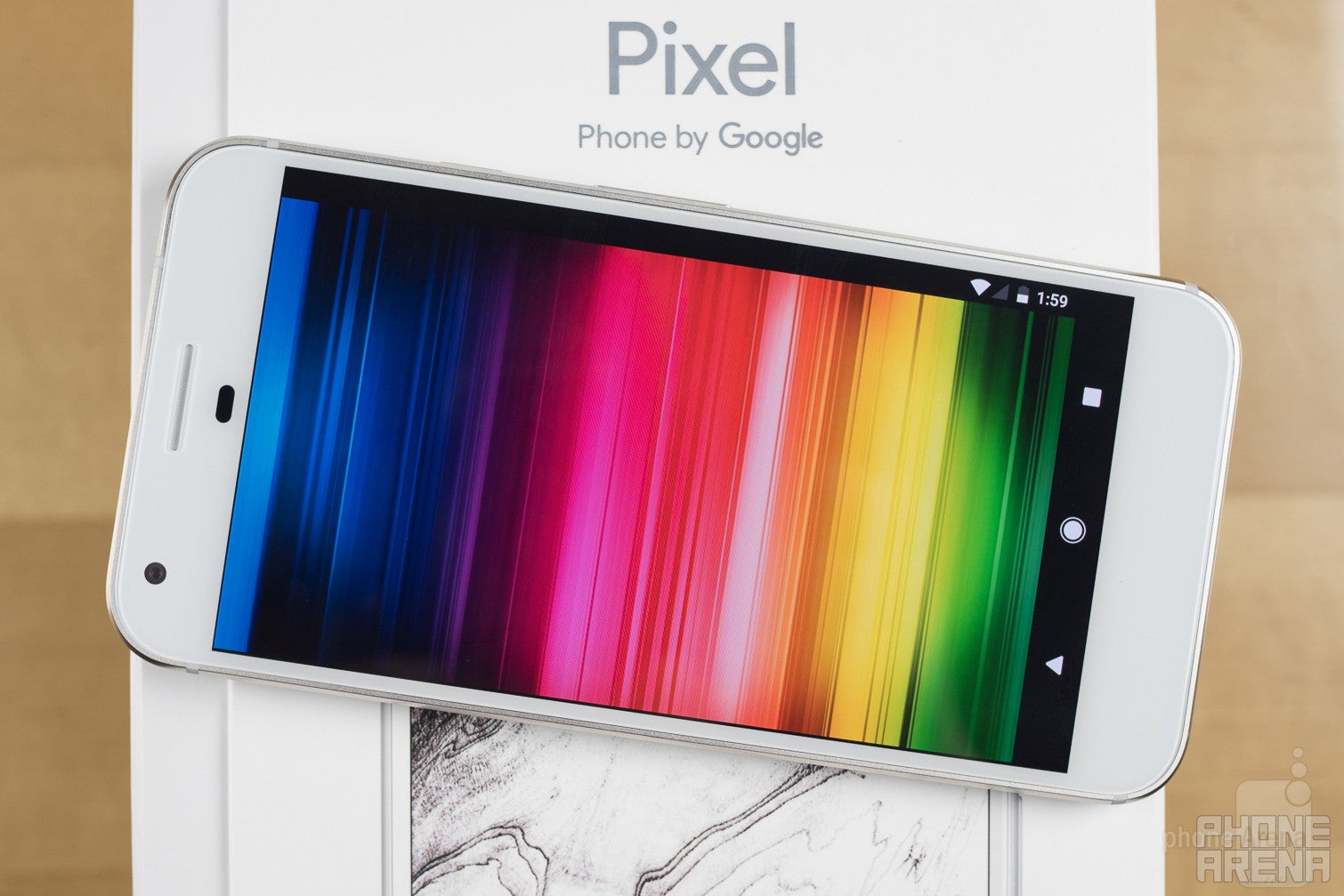
Like the 5.7-inch panel on the Nexus 6P, the 5.5-inch screen on the Pixel XL is an AMOLED component, returning with the same quad-HD 1440 x 2560 resolution. It's protected by Gorilla Glass 4, which has an ever-so-slight curved-edge effect.
As we'd only expect form an AMOLED display, colors are really bold, with bright, saturated hues and inky-dark blacks. White balance looks good (but not great) in our tests, but the color gamut itself is a bit over-saturated.
Brightness, however, is more middle-of-the-road, and more than once we found ourselves wishing we could crank the display up brighter while out in early afternoon sunlight – the Pixel XL is still visible enough, but a slightly brighter screen would sure help with usability.
Indoors, the situation's a lot more favorable, and users who like to read in bed will especially appreciate just how low brightness can go. And while Google doesn't offer any tweaked display modes, or tools for fine-tuning color balance, we do see the presence of a “Night Light” feature, dialing-down blue colors in an effort to improve eye comfort while viewing at night.
Interface and Functionality
Google goes out on a limb with Nougat, yet the changes feel really successful
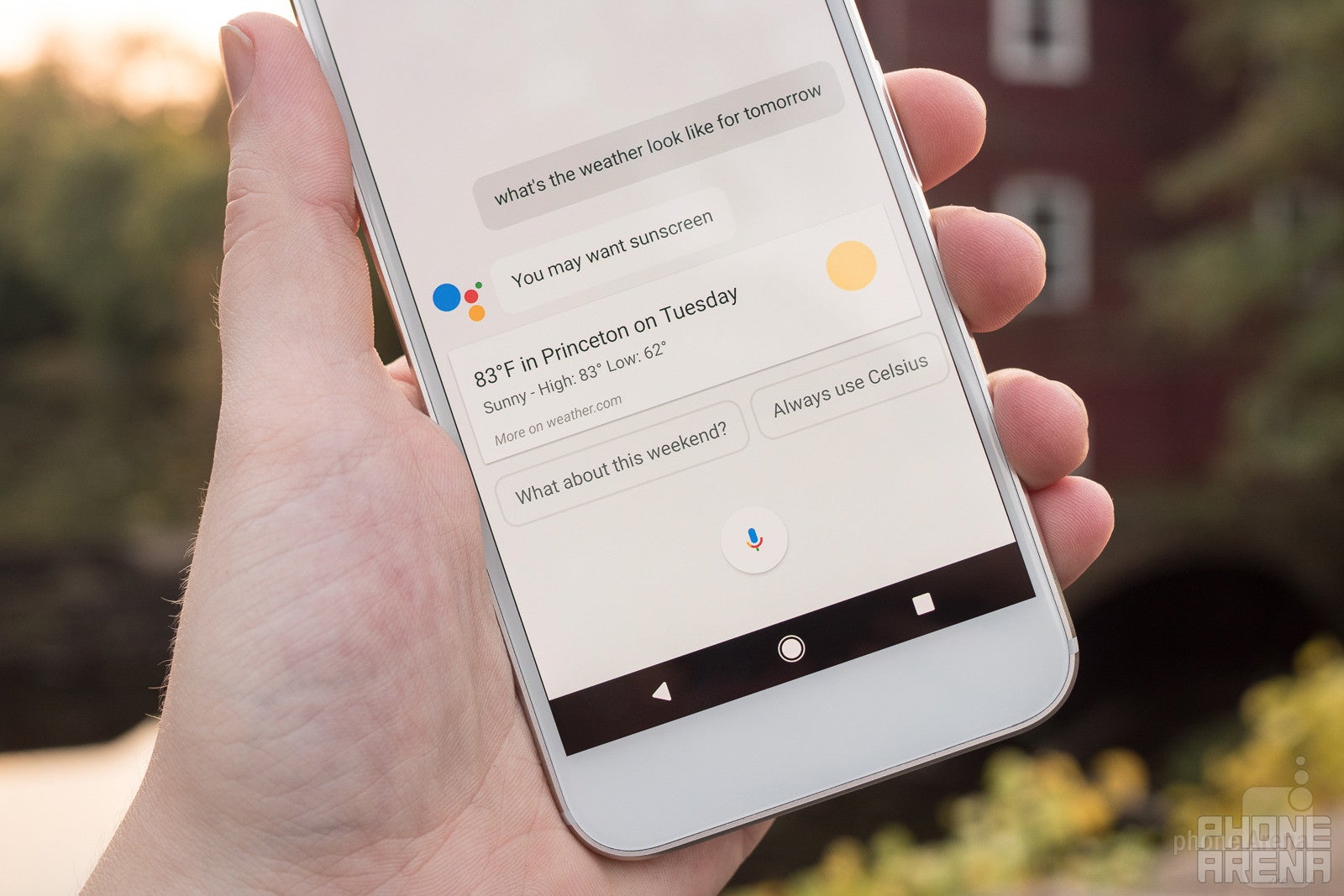
The Pixel phones may not be the first to launch with Nougat, but they do hold the honor of introducing us to Nougat's latest incarnation: Android 7.1. That means the arrival of new features like the long-awaited split-screen mode for apps, as well as changes to familiar areas of the Android interface, like the display of notifications.
One of the most jarring, at least for users expecting a traditional app drawer, is the new way software is accessed, by way of a swipe up from the screen's bottom edge. While at first you may find yourself continuing to hunt for the right icon to tap to, the movement quickly becomes second nature, and we can't see users having too many objections.
Another noteworthy change to the way you access expected Android features concerns the standard Google search-bar widget. The one you know and love is still present, waiting for you to drop it into place if you so choose, but the Pixel XL is instead pushing users in a new direction, with a slightly less conspicuous pop-out search bar that spends its days tucked away in a corner of the home screen, just waiting for someone to tap and expand it.
There's also a new way to get to Google's voice-drive assistant, now with a major makeover in the form of the Google Assistant. In addition to saying “OK Google” anytime you like (even with the screen off), you can access the Assistant by briefly holding down the on-screen virtual home button (since the swipe-up mechanic is now the new app drawer).
The Assistant isn't some all-new voice-powered solution, and if you're familiar with Google Now, this is going to seem like the natural progression of things – in fact, “natural” may be the key word here, as the Google Assistant really focuses on back-and-forth spoken interactions with users that can be utterly conversational in tone.
At least, that's the dream – and it works with some queries, picking up on contextual cues. Others are less successful, and far too often for our taste responses from Assistant simply dumped us into a web-search result.
When you take full advantage of Google's software and services, the results can be pretty impressive – though we can imagine privacy advocates being a little sketched out. The phone will recognize when you're hanging around at a restaurant or shopping center, and helpfully trigger a notification with menus and review, or an in-store Maps diagram to help you find your way around. Like other recent Android builds, you get from Nougat what you put into it, and the closer you allow Google to scrape your mails, appointments, search history, and location data, the more interesting and often legitimately useful information it will offer to share with you.
If something does go wrong with your Pixel XL experience, help is just a few taps away, thanks to Google's 24/7 support, accessible both via phone and online chat.
Finally, while fingerprint scanners were introduced to Nexus phones last year, the “Pixel Imprint” scanner on the Pixel XL is a particularly nice one, offering a really neat gesture control: while using the phone, you can swipe down across the scanner to access your notifications – or swipe twice for expanded quick settings. It's the same effect as if you swiped down on the screen itself, but really, really convenient to use.
Processor and Memory
Google doesn't skimp on the latest silicon, but performance gains aren't huge
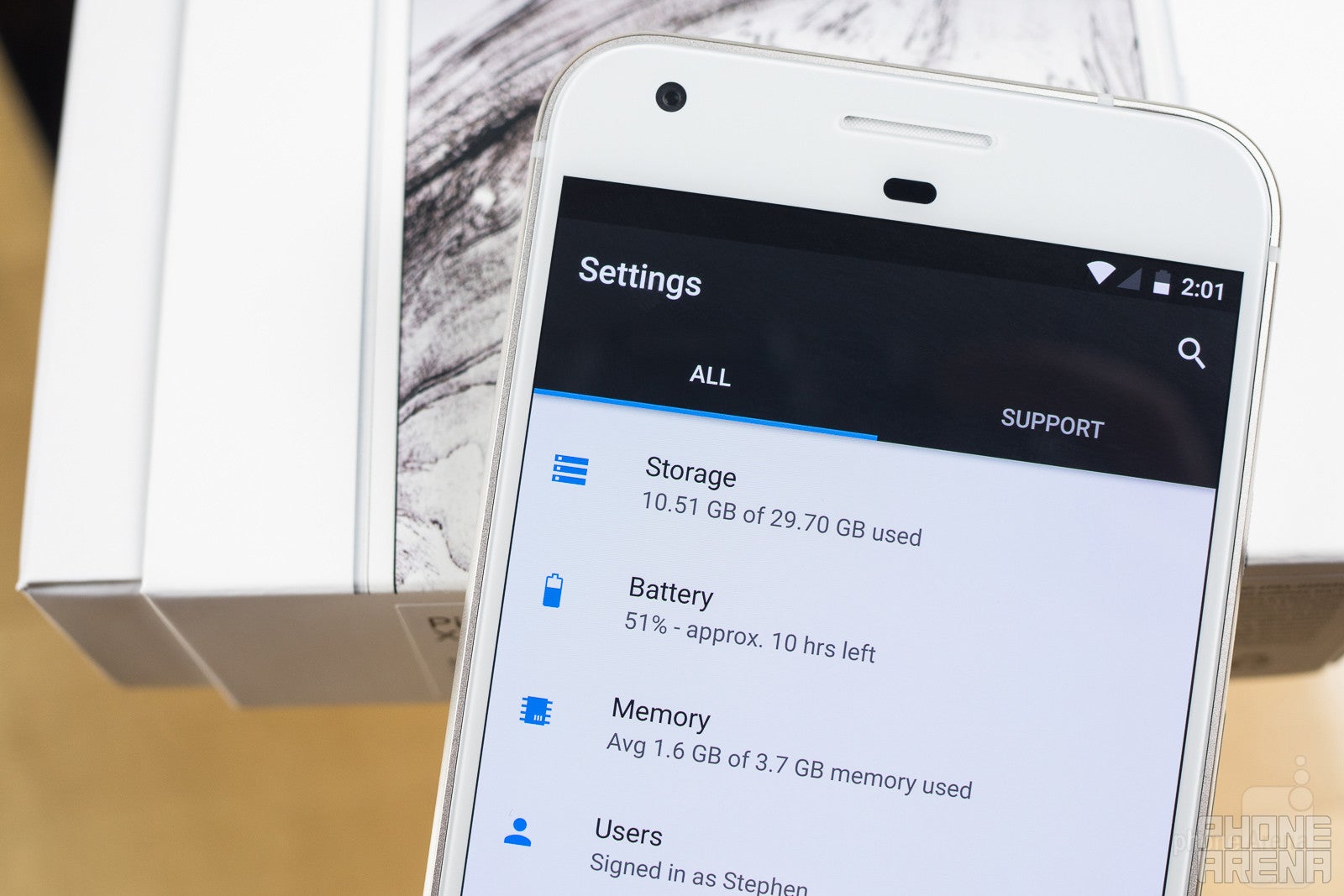
This year's been populated by flagship after flagship running Qualcomm's Snapdragon 820 processor. It's a very capable chip, but after so many phones offering similar capabilities, we've been itching to check out the next big thing. There's bound to be some debate over just how “big” it really is, but the follow-up to that chip is now here, with the Pixel XL packing a new Snapdragon 821.
That single-digit model-number bump should help soften the news that we're not looking at a major overhaul of the 820's capabilities, but instead a chip that's a little bit faster – Qualcomm says that users can expect a speed increase in the range of 10 percent.
Our benchmark tests didn't show the 821 coming out ahead of the 820 in every situation we threw at it, but most of the time it was either neck-and-neck with the 820 or – true to Qualcomm's promises – slightly ahead. So while you shouldn't expect the Pixel XL to run circles around existing 2016 flagships, it's definitely up there in the upper echelons of their ranks.
Google pairs that chip with 4GB of RAM, which we'd only expect for a phone of this stature. While some users have debated the need for phones with quite so much memory, we're hoping that things like Nougat's split-screen multitasking will begin convincing them why it's very much in our interests to have RAM to spare.
Storage options include 32GB and 128GB models, with no microSD expansion. While the 32GB base level is fine, it might have been nice to see 64GB, instead – especially after the arrival of the Note 7. But with Google's free-storage offer for the Pixel XL's photos and video leveraging some cloud muscle to take the pressure of local storage, we can understand how 32GB can look like more than enough.
Subjectively, the Pixel XL is smooth as butter to use. The combination of the latest Android software and a next-gen processor gives us an interface that just soars by under our fingertips, as if the pixels wish they had a reason to move just a bit faster, if only to show what they can really do. From system menus, to Maps, to Chrome, to the camera, the user experience is fast and responsive all around.
Connectivity
LTE capabilities so fast, your carrier may be afraid of it
So far we've been looking at hardware that's at the forefront of the latest tech, and that story continues for the Pixel XL's wireless connectivity. Your carrier may not support high-speed LTE Cat 12 just yet, but when it does the Pixel XL's ready to pull down blistering 600Mbps download speeds.
On the wired front, Google's going all-in with USB Type-C, after introducing the connector to the Nexus 5X and 6P last year. That means shipping the Pixel XL with a nice assortment of Type-C cables, as well as adapters ready to interface the handset with your existing gear – including a Quick Switch adapter you can use to bring your old messages, contacts, and files over to the new phone.
Camera
This camera may be powered by ego, but when you're as big as Google, that actually works
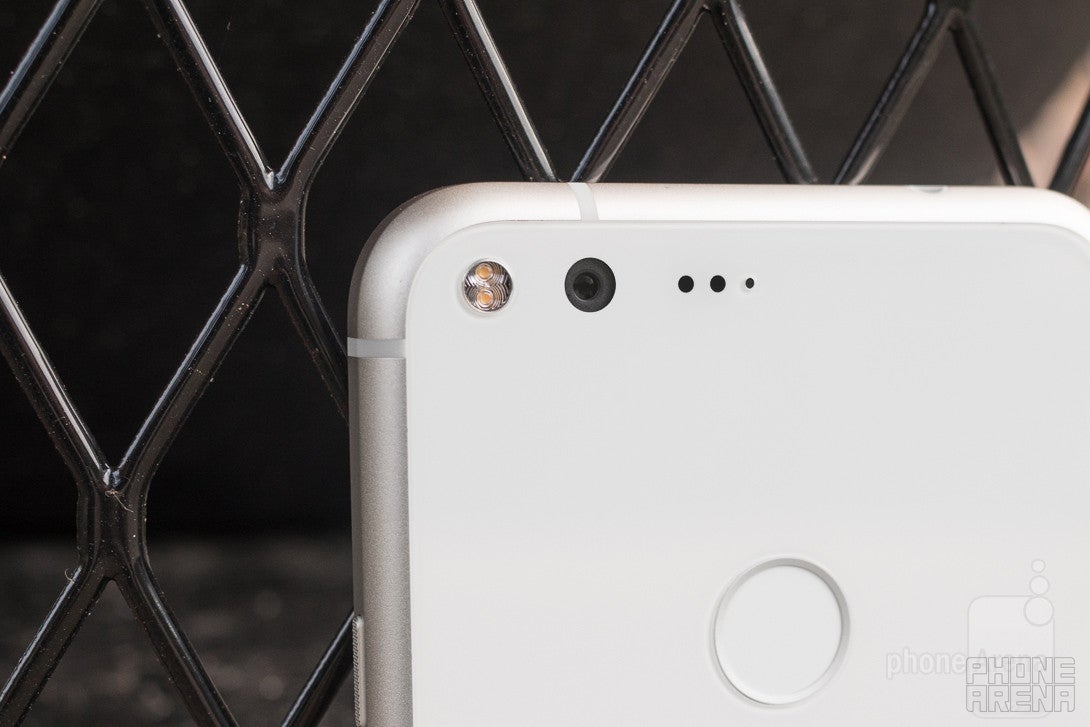
Like a lot of other recent flagships, Google's making some big claims when it comes to the Pixel XL's camera performance. In its promotion for the handset, the company doesn't mince any words, calling this “the highest rated smartphone camera. Ever.”
Around back we've got a 12.3MP camera with an f/2.0 aperture lens and big 1.55μm pixels. And up front there's an 8MP selfie cam. But more than resting the Pixel XL's reputation on the camera hardware itself, Google turns to software and additional sensor hardware to really get the most out of these sensors.
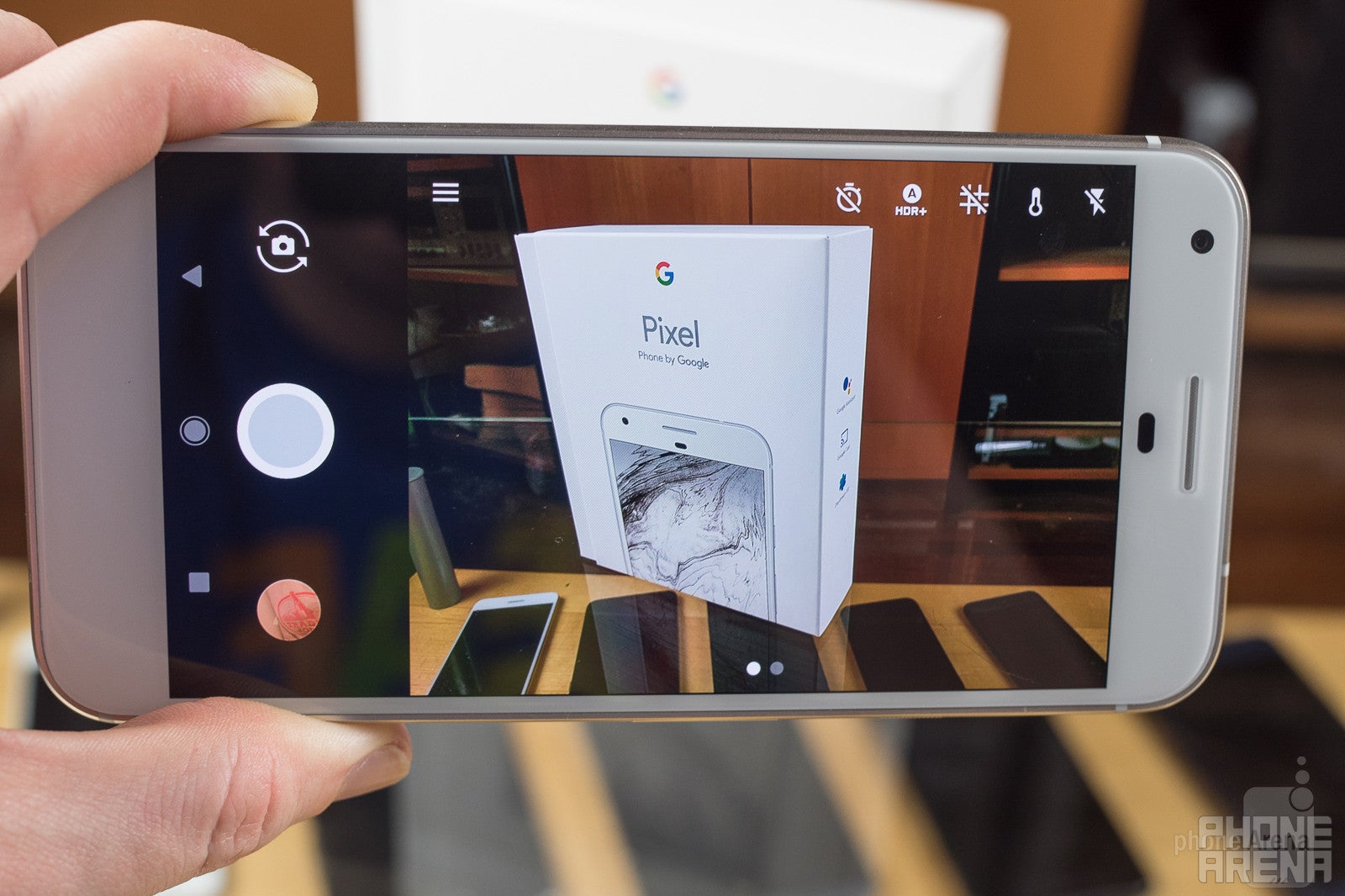
Image quality
Fast and high-quality, it's a point-and-shoot fan's best friend
Google may be aiming for the stars with the Pixel XL's camera, but to a large extent, it really does deliver. The camera's fast as hell to use, grabbing focus in a snap thanks to both its phase-detection and laser-assisted techniques, and even HDR processing doesn't really slow things down.
About those HDR capabilities, though: while they work well and produce some nice-looking shots, we couldn't help but notice Google being a little heavy-handed in steering users towards them. While camera settings like your flash preferences or what resolution you want to shoot in are recalled for future photo sessions (as right they should be), every time you jump back into the camera app it defaults to auto-HDR; there's no way to force the phone to remember that you'd prefer to have HDR off by default. That's ultimately a minor quibble, thanks to how painless it is to have the auto-mode engaged.
Even some tricky exposures with blown-out backgrounds ended up looking pretty nice, and while the camera struggled with focus occasionally in extreme low-light environments, the images it grabbed were impressively low-noise, with nice clean blacks.
We're not sure if it's really the best camera ever on a smartphone – that's one heck of a high bar – but the Pixel XL is very much up there among some of the best-performing models you can pick up today.
Video recording
Who needs a tripod when digital stabilization works this well?
A lot of the good stuff from the Pixel XL's still-image performance carries over to video, especially in terms of focus speed – refocusing during video recording is fast and effortless.
The camera supports shooting modes up to 4K (as we'd only hope), but the real story is less about resolution and more about stability. While the Pixel XL doesn't offer an optically-stabilized camera, it does take advantage of Google's advanced stabilization algorithms, acting in concert with on-board sensors to digitally remove camera-shake from your footage.
We've seen plenty of software-stabilization efforts from other phones, but Google's implementation really does appear to live up to the hype. While the “laggy” effect on the viewfinder can be a little distracting while filming, the end results are incredibly impressive, especially compared to unstabilized video.
Multimedia
Great, well-balanced sound, but we crave a return to stereo
Last year, the Nexus 6P had a pair of dual front-facing speakers. Unfortunately, the Pixel XL can't quite live up to the same expectations, moving back to a single bottom-edge speaker.
What it lacks in lush stereo sound, though, the speaker goes a long way towards making up for that with really nice, clear, balanced sound. You get crisp highs and thumping lows, all without much discernible distortion. And though this isn't the loudest speaker we've ever tested, it subjectively feels extremely powerful with its output.
Call Quality
Voice isn't dead yet, and the Pixel XL makes it sound like it never will be
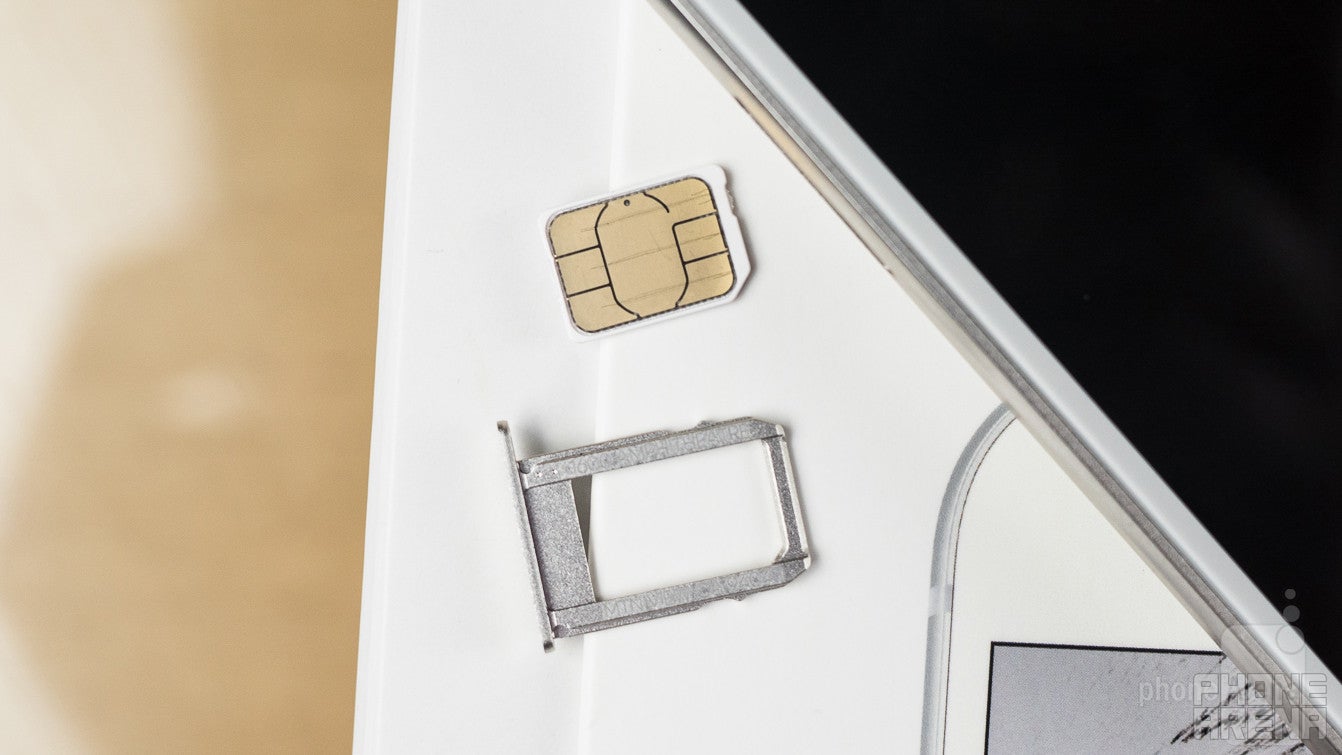
Given the high-end radio hardware and software within the Pixel XL (the kit responsible for offering that super high-speed LTE Cat 12 bandwidth), it's little surprise that when tasked with basic voice calls, the phone also excels.
Maybe “excel” is the wrong word, as we're really not looking for much here but clean, intelligible call quality, but the Pixel XL certainly doesn't drop the ball. While the phone's size makes it a little less comfortable to use than more petite handsets, everything still sounds great, and with the Verizon SIM we tested, neither ourselves nor our callers had any major complaints.
Battery Life
Long life and fast recharging makes for a great pair – but would it kill to have wireless support?
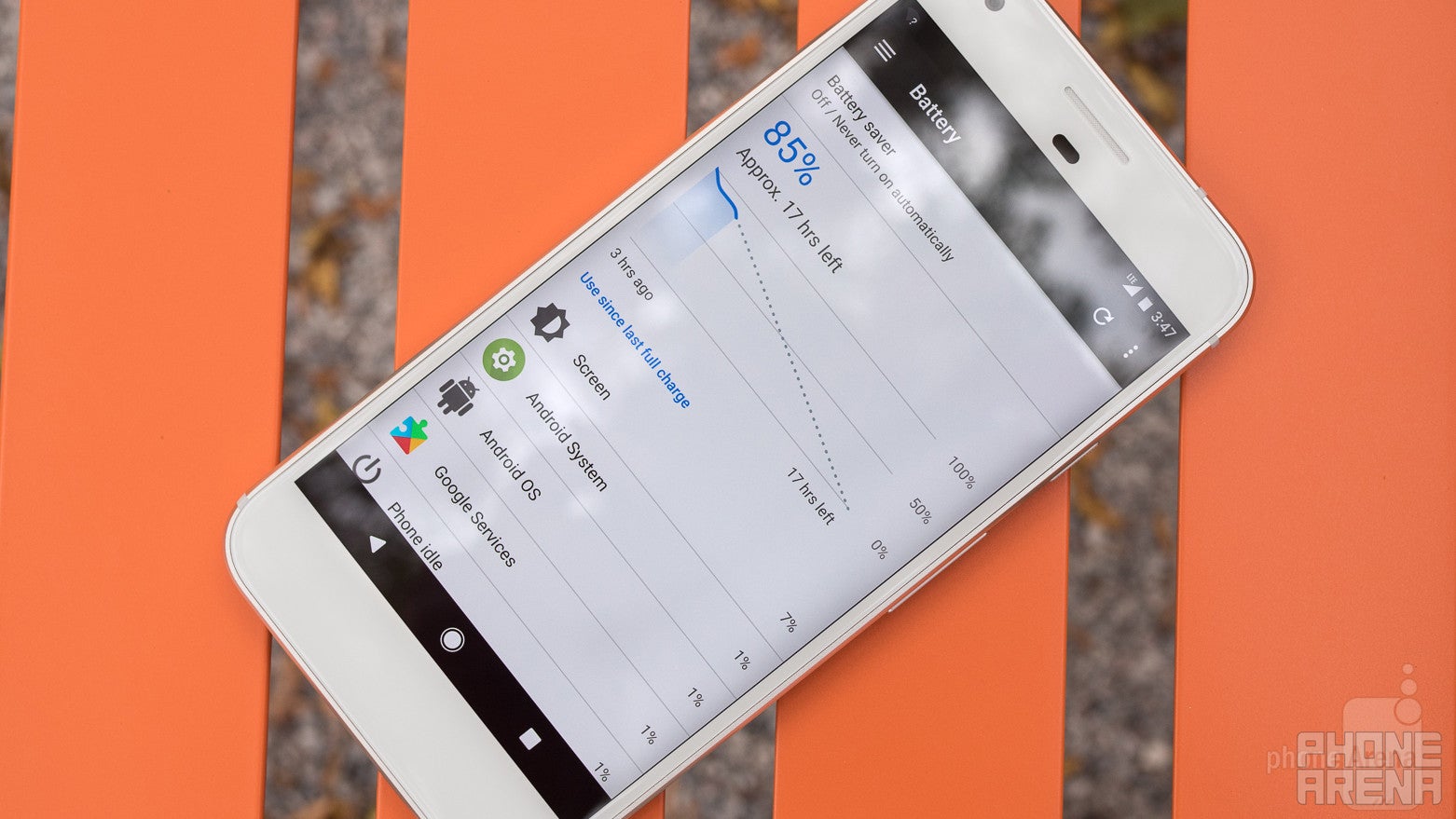
Google gives the Pixel XL a 3,450mAh battery, the same capacity as the Nexus 6P. In our custom battery tests, that translated into a little under seven-and-a-half hours of continuous screen-on time. Compared to other phones with similar hardware, that's in the right ballpark of expectations; it's nothing game-changing, but nor does it disappoint.
With careful usage, we were sometimes able to stretch life into a second day of operation without recharging, but it wasn't long before we were hunting down an outlet to make sure we kept our charge on the right side of things.
Sadly, there's no wireless-charging support, but the included USB Type-C adapter is a fast-charging 18W component. From a dead battery, that gave us a full charge in under two hours. And if you only need a little extra juice, even just fifteen minutes plugged in can give you several hours of operation (though primarily in standby).
What's really cool about the charger is that it's got a USB Type-C port on it – something we can't say about many other chargers shipping with Type-C-enabled phones. That means your charging cable is fully reversible, not just up-and-down but end-to-end. That may not sound like much, but it really follows through on the dream of Type-C solving so many (even minor) legacy-USB headaches.
Conclusion
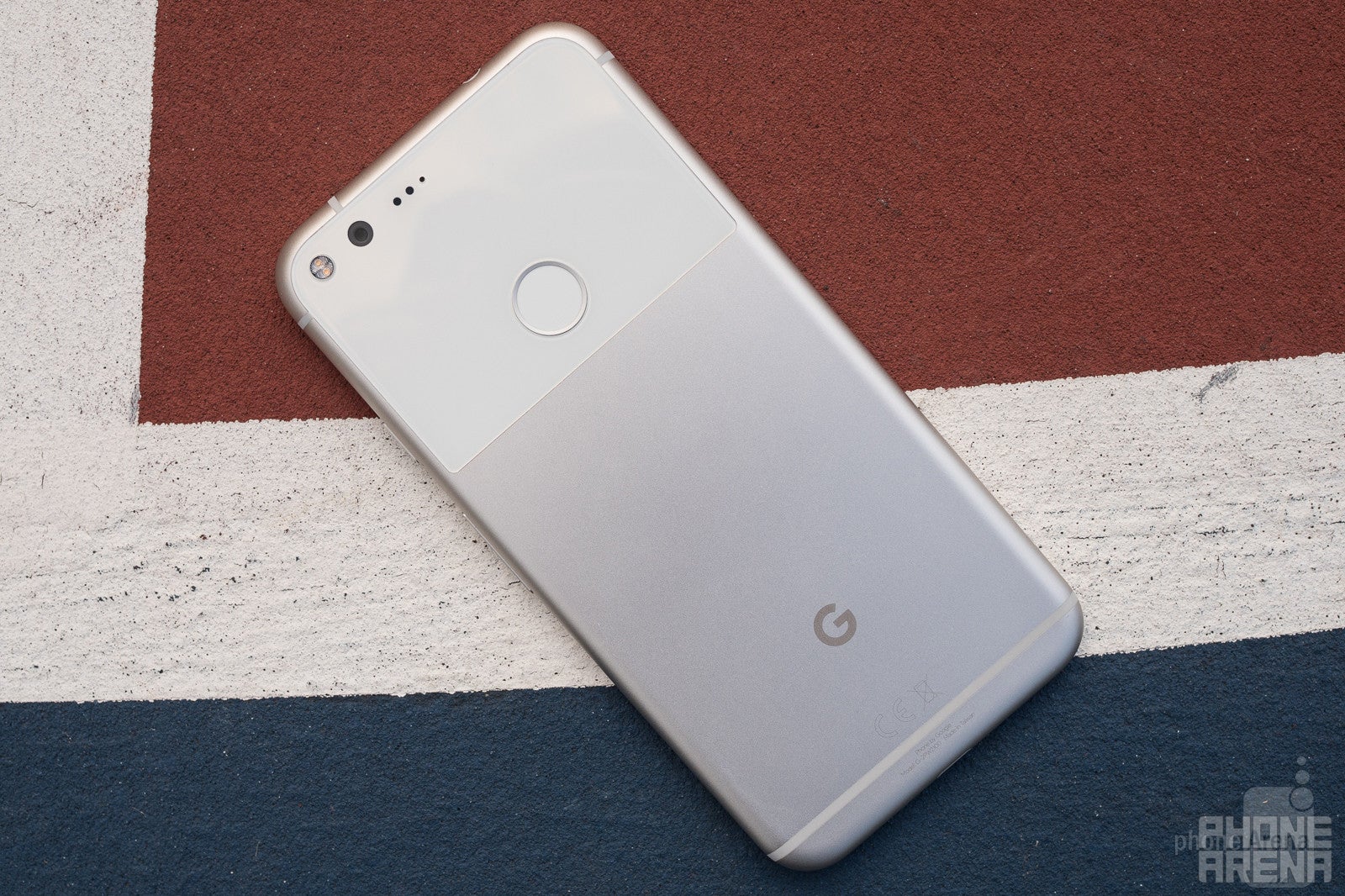
The Pixel XL is a phone on a mission, looking to not only draw attention to Google's prowess as the company behind advanced smartphone software and service, but also as a company that can design some attractive, high-end, and most importantly desirable hardware. HTC may be building the phone, but Google's calling the shots, and its ambition shows.
That puts a lot on the line for Google, but for the most part it doesn't mess up anything of consequence. Sure, we wish a few extra features were present, from wireless charging to FM reception. And while the display could be brighter or better-calibrated, it's still sharp, colorful, and largely gets the job done.
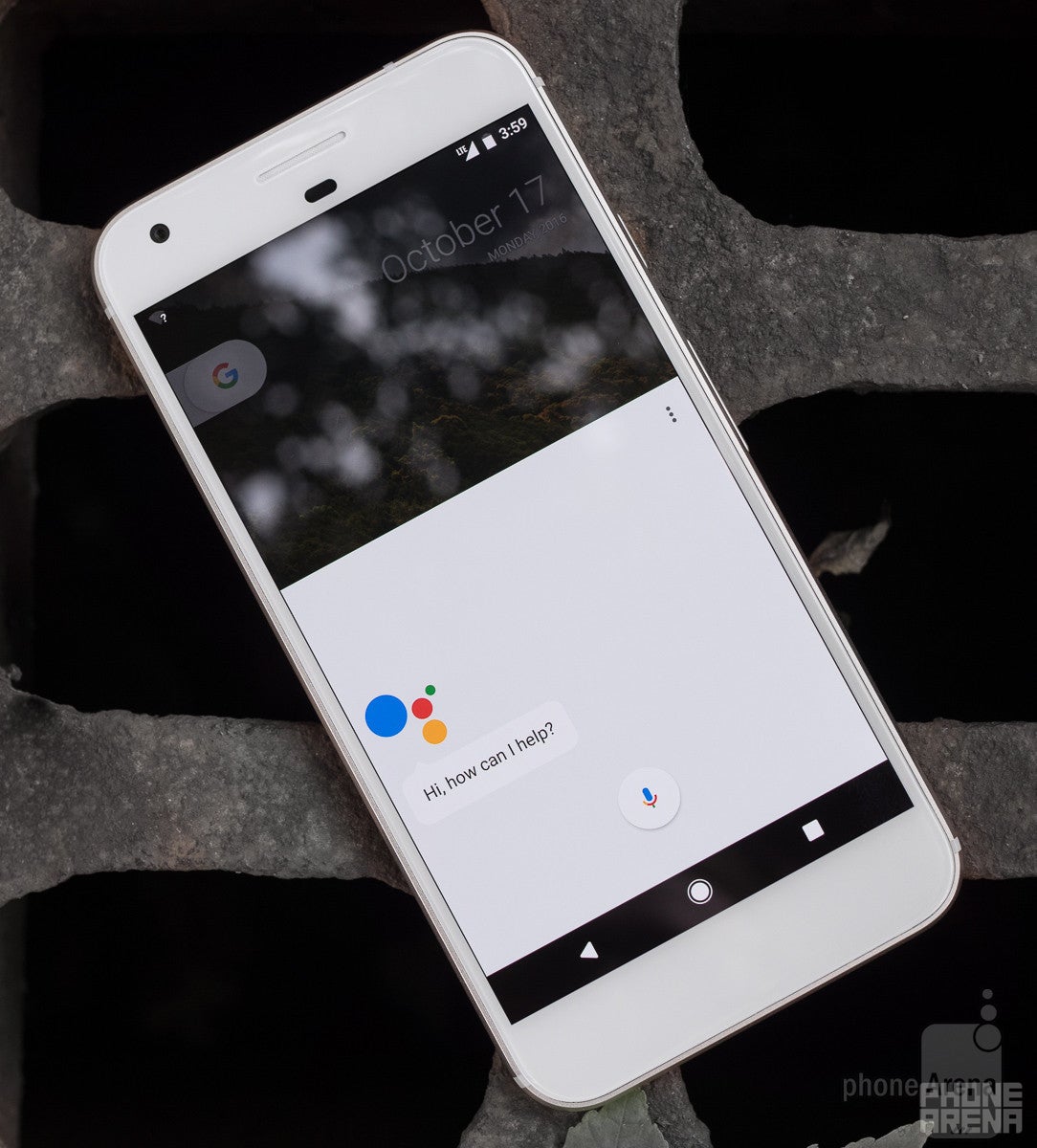
If there's one big thing that gives us pause, though, it's the phone's pricing: the XL adds $120 to the Pixel's already flagship-level $650 price tag, and moving from 32GB to 128 GB bumps things up $100 further still. And while $770 phones are far from unheard of, Google hasn't really established itself as a super-premium phone brand in the eyes of many shoppers.
Now, will the Pixel XL help change their minds about that? Well, like we said, it's one really quite well-done phone. But it's also maybe not quite flashy enough, nor armed with sufficient bells and whistles to justify its price in the eyes of some shoppers.
Who's the Pixel XL for, then? Really, this phone is all about Google's services, and if you're already an Android user with your pics, movies, music, communications, and all that good stuff tied up with Google's servers, the Pixel XL will be ready to hit the ground running, giving you a really tight, nicely integrated smartphone experience. The Pixel brand represents a new beginning for Google's smartphone efforts, and this looks like a great place to start.
Software version of the review unit:Android 7.1 Build NAE63P

Update: You can now read our Google Pixel 2 and Pixel 2 XL review!
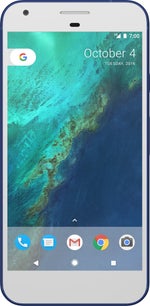
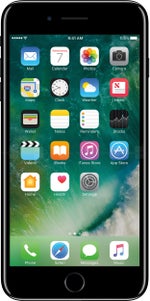

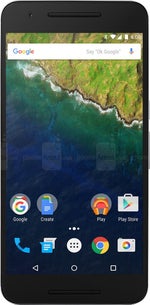































Things that are NOT allowed: